On October 8, the names of the 2019 Nobel Prize winners in physics were announced at the Royal Swedish Academy of Sciences. According to Academy Secretary General Goran Hansson, the award "for contributing to our understanding of the evolution of the Universe and the place of the Earth in space" was shared by the American theoretical physicist in the field of cosmology James Peebles and two Swiss astrophysicists Michel Mayor and Didier Kelo.
This year, the winners had a very serious competition - experts and bookmakers predicted that the prize would most likely be awarded for a breakthrough in quantum cryptography or for obtaining the first image of a black hole, but the Swedish academics decided differently.
- From left to right: James Peebles (USA), Michelle Major and Didier Kelo (Switzerland)
- © nobelprize.org
James Peebles's theoretical research in the field of physical cosmology has been known since the 1960s. The scientist contributed to the formation of many modern ideas about the Universe, including the mysterious relict radiation that filled it after the Big Bang. As noted in the Nobel Committee, the results of Peebles' "showed the world", 95% of which is hidden mass, which includes unknown dark matter and dark energy.
“For young people who are taking their first steps in science, I advise you to be guided by love for it. Take this path because it is simply amazing, ”James Peebles said over the phone at the ceremony to announce the winners.
In turn, two Swiss astrophysicists - Michel Mayor and Didier Kelo, were awarded a high award for scientific research in the field of exoplanets. It was they who in October 1995 discovered the first object of this type - the exoplanet 51 Pegasus b, which revolves around a star very similar to the Sun. However, to the astonishment of scientists, the planet itself, later named Dimidius, and its entire star system Helvetios turned out to be noticeably different from our solar system.
Dimidium is a large gas giant, while its circular orbit is quite small. He revolves around his star in just 4.23 Earth days.
After the discovery of Swiss scientists, a real “boom” began in the search for exoplanets, striking in a variety of sizes, shapes and orbits - more than 4 thousand of them have already been found in the Milky Way. The Nobel Committee is sure that ultimately humanity will be able to find the answer to a key question - Does extraterrestrial life exist.
Recall that it was physics that became the first discipline that Alfred Nobel included in his will. Domestic scientists have repeatedly received the Nobel Prize in this field of science. Among them - Zhores Alferov, who opened the way for people to the world of electronics and digital technologies. In addition, the Russian Konstantin Novosyolov and the Soviet (now Dutch and British) physicist Andrei Game were awarded the prestigious award for the discovery of graphene.
Recall, the size of the Nobel Prize is 9 million Swedish kronor (about $ 918 thousand). The award will be traditionally presented on December 10 - the day of memory of the Swedish inventor Alfred Nobel.

